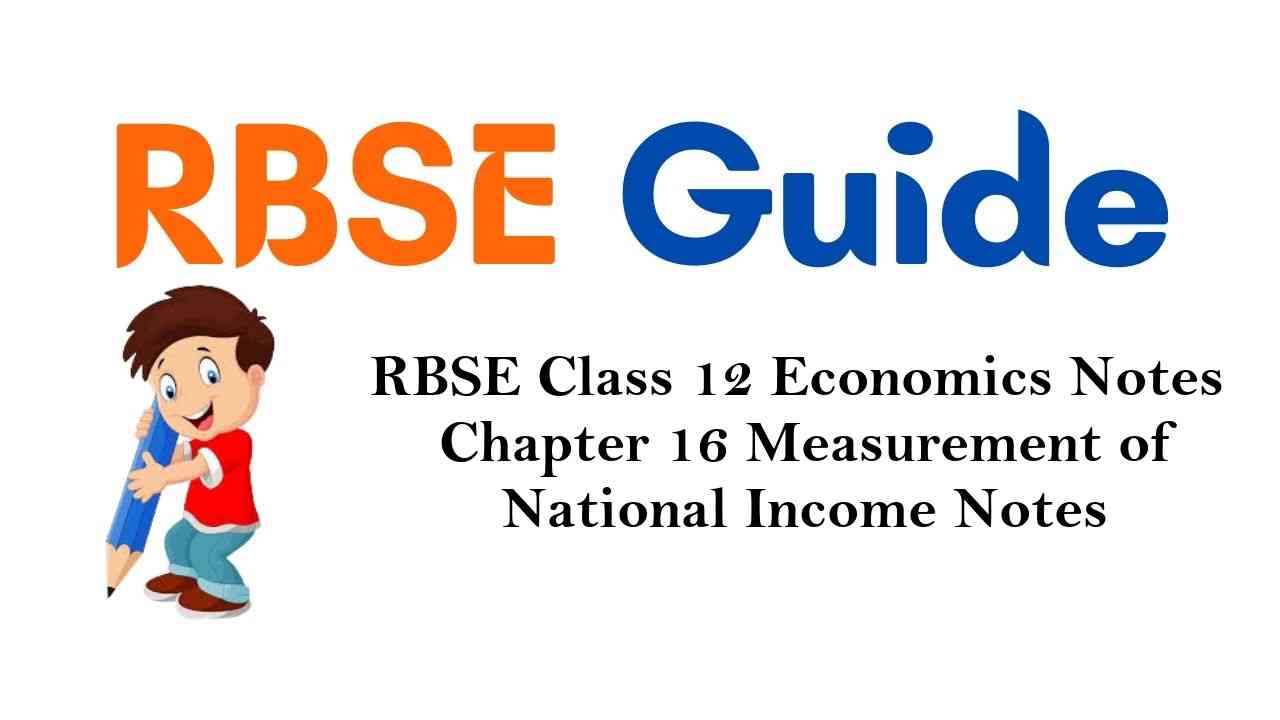Rajasthan Board RBSE Class 12 Economics Notes Chapter 16 Measurement of National Income
National income is calculated for economic analysis, future prediction and policy making.
Effect of national income is cyclic.
Because of the cyclic effect of national income, expenditure of one party is the income of another. ,
National income can be calculated by three methods : Value-added method or Production method, Income method and Expenditure method.
In the value-added method, the value of the final goods and services produced by various services sectors is taken.
Value of production is calculated by multiplying the quantity of final usable goods and services by its prices.
Sum of value of various goods and services is called Gross Domestic Product.
Some goods and services have interim or intermediate nature which can be used further in production.
These interim goods are not included in the computation of National Income.
Value-added method of production method is used for preventing the double counting of national income.
![]()
For counting the net national income, value depreciation is deducted from.gross national income.
The part of production received by factors of production is the basis of calculation of national income by income method.
Gross National income (using Income method) = Gross rent + Gross wages + Gross interest + Gross profit + depreciation.
While computing gross national income by income method, income from self employment, wages received in the form of goods and services, rent saved by living in own house, declaring less income or no income to government (its value), and value of part of production kept for oneself are to be added.
National income (NNPFC) is calculated by adding net factor income from abroad to net domestic income (NDPFC).
In Expenditure method, national income is measured in terms of expenditure on the purchase of final goods and services produced in the economy during an accounting year.
In the expenditure method of computing Gross national income, the value of private consumption, capital consumption, government expenditure and depreciation is added.
National income and economic welfare are mutually related.
![]()
Level of economic welfare goes up when national income is distributed equally.
Level of economic welfare goes down when national income is distributed unequally.
Nowadays, economic welfare is seen connected to state of environment. Green accounting method is used for this.
Under this method, quantity of loss to environment is deducted from National income and modified national income is calculated.
Important Glossary
- National Income : Monetary value of all the goods and services produced in a country in a year is called-national income.
- Consumer goods : The goods which the consumers utilize for the fulfilment of their needs are called consumer goods.
- Capital goods : Goods which are utilised for the production of other goods are called capital goods.
- Final goods : The goods which are used ultimately by consumers to fulfil their needs are called final goods.
- Non-durable consumer goods : The goods which perish after single use.
- Durable Consumer goods : The goods which last for long and are used for a long time are called durable consumer goods.
- Circular flow of income : The flow of income is circular because expenditure of one is the income of other, and that income spent again will become income for another one. This process goes on and is called circular flow of income.
- Gross domestic product : The value of all the goods and services produced in an economy in a certain year is called gross domestic product.
- Gross national product : The total value of goods produced and services provided by a country during one year, equal to the gross domestic product plus the net factor income from abroad.
- Depreciation : A reduction in the value of means of production over time, due to wear and tear in the process of production.
- Inventory : Stock of raw material, semi-finished goods and unsold goods at the end of the year is called inventory.
- Investment: The expenditure done for production is called investment. Inestment increases capital stock.
- Government Expenditure : Government expenditure includes expenditure on govt, employees, expenditure on medical care, defence and law and order.
- Personal consumption expenditure : It includes those expenditures which are done by persons and families to fulfil their needs. The expenditures may be done on nondurable consumer goods, durable consumer goods and consumer services. ‘
- Net export expenditure : Net export refer to the value of a country’s total exports minus the value of its total imports. It is used to calculate a country’s aggregate expenditures or GDP in an open economy.
- Barter : It is a system of exchange where goods or services are directly exchanged for other goods or services without the use of currency.
- Division of Labour : The assignment of different parts of a manufacturing process or task to different people in order to improve efficiency.
- Specialization : Placing a person on the job according to his efficiency is called specialization. It increases the quality of work.
- Green Accounting : Green accounting is a type of accounting that attempts to factor environmental costs in the financial result of operations.
- Sustainable development: Under this concept, such policies of development are made which not only fulfil the present human needs, but also ensure the fulfilment of needs in the future.
